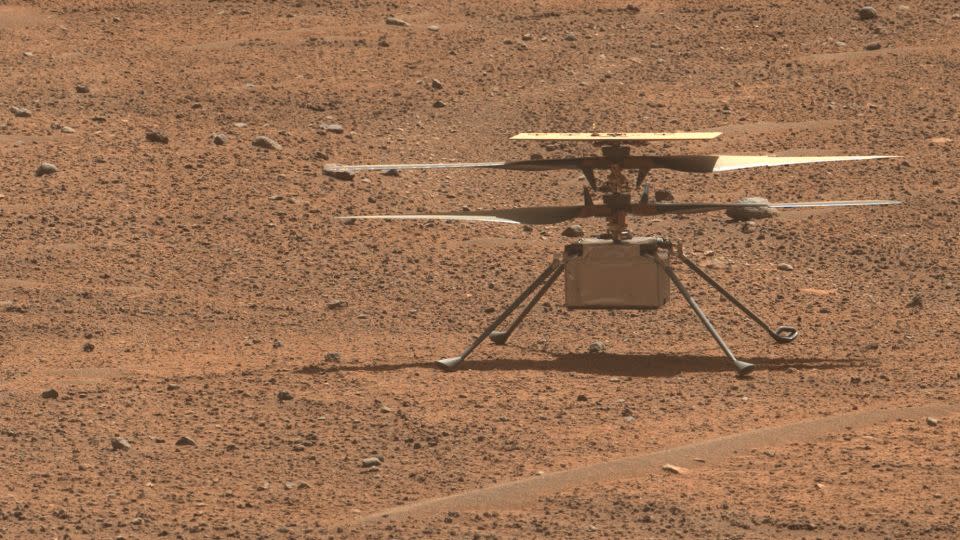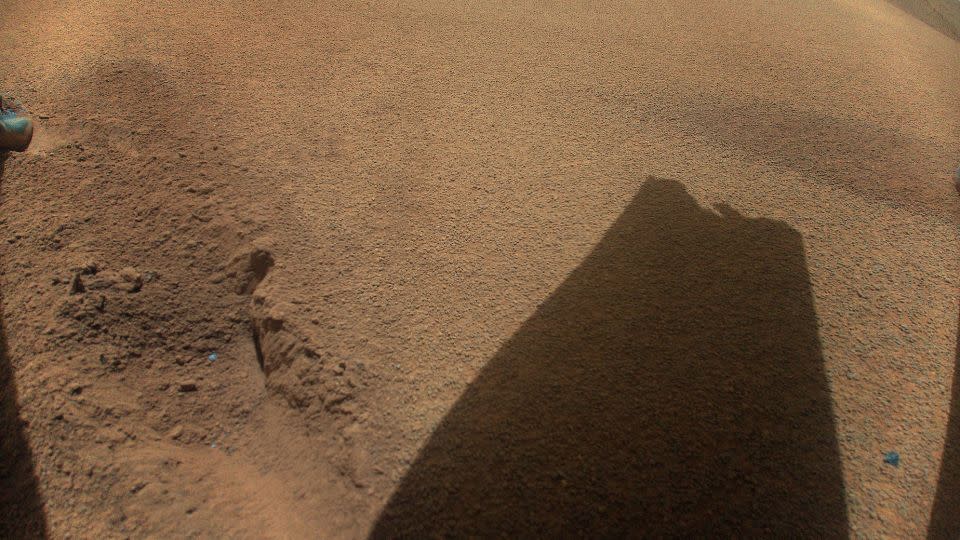After damaging a rotor blade, NASA’s Ingenuity helicopter mission ends on Mars

Sign up for CNN’s Wonder Theory science newsletter. Explore the universe with news on fascinating discoveries, scientific advancements and more.
After completing 72 historic flights on Mars over three years, NASA’s Ingenuity helicopter mission has ended.
Originally designed as an experiment, Ingenuity became the first aircraft to operate and fly on another world, lifting off on April 19, 2021.
Imagery and data returned to NASA’s Jet Propulsion Laboratory in Pasadena, California, showed that one or more of the chopper’s carbon fiber rotor blades was damaged while landing during its final flight this month. The team determined that the helicopter is no longer able to fly, according to the space agency.
Ingenuity, which had traveled to Mars as the Perseverance rover’s trusty sidekick, is sitting upright on the surface of the red planet, and mission controllers at NASA’s Jet Propulsion Laboratory have been able to maintain communications with the rotorcraft.

The NASA mission team only expected the chopper to carry out five test flights in 30 days. After acing its five expected flights, Ingenuity graduated from its role as an experiment to serving as an aerial scout for the Perseverance rover. The chopper flew over areas of scientific interest to capture images and help the mission team determine Perseverance’s next targets for detailed analysis. The helicopter carried out its final flight on January 18.
Together, the rover and helicopter spent the past few years exploring Jezero Crater, the site of an ancient lake and river delta on Mars. Scientists are hoping that samples collected by Perseverance, which will be returned to Earth by future missions, could determine whether life ever existed on the red planet.
“The historic journey of Ingenuity, the first aircraft on another planet, has come to end,” said NASA Administrator Bill Nelson, in a statement. “That remarkable helicopter flew higher and farther than we ever imagined and helped NASA do what we do best — make the impossible, possible. Through missions like Ingenuity, NASA is paving the way for future flight in our solar system and smarter, safer human exploration to Mars and beyond.”
Apart from achieving the first Wright brothers moment on another planet, Ingenuity logged many milestones. It flew 14 times farther and 33 times longer than planned, logging more than 2 hours of flight time.
“At NASA JPL, innovation is at the heart of what we do,” said Laurie Leshin, director of the Jet Propulsion Laboratory, in a statement. “Ingenuity is an exemplar of the way we push the boundaries of what’s possible every day. I’m incredibly proud of our team behind this historic technological achievement and eager to see what they’ll invent next.”
As the first space helicopter, Ingenuity has been compared with the Wright Flyer, the first heavier-than-air, powered aircraft to fly successfully on Earth in 1903. The Wright Flyer flew four times on its first day of flight before being blown over and broken by the wind, Leshin said. The feat is still considered one of humanity’s greatest achievements, and now Ingenuity joins the Wright Flyer as a history-making aircraft that has proved new capabilities.
“It’s humbling Ingenuity not only carries onboard a swatch from the original Wright Flyer, but also this helicopter followed in its footsteps and proved flight is possible on another world,” said Teddy Tzanetos, Ingenuity’s project manager at JPL, in a statement.
What went wrong
Ingenuity was scheduled to make a short vertical flight, known as a hop, on January 18 to help the mission team determine its exact location. The helicopter experienced an emergency landing on its previous flight, flight 71.
During flight 72, Ingenuity rose about 40 feet (12 meters) in the air, hovered for 4.5 seconds and began to descend at 3.3 feet per second (1 meter per second).
But when the chopper was 3 feet (1 meter) above the Martian surface, the mission team lost communication with Ingenuity because it stopped sending data to the rover. The helicopter relies on Perseverance to serve as its communications relay because Ingenuity doesn’t have a way of independently exchanging data with Earth.

Communications were restored with Ingenuity the next day, allowing the mission team to analyze the flight data and see images that revealed at least one damaged rotor blade.
The team is still investigating the cause of the communications blackout and the helicopter’s orientation as it touched down. It’s possible that one of the blades struck the ground during landing, Nelson said.
The team estimates that 25% of the end of the blade is missing, Tzanetos said.
Ingenuity will not attempt any additional flights to test the capability of its rotors because helicopters must be impeccably balanced in order to fly, he said. Most of the lift comes from the last 25% to 35% of the rotor system, and Ingenuity has lost a key part of its thrust capacity.
Whether or not the blade strike occurred and caused the communication loss or a power brownout caused the rotor strike, the team will never know because the data was not saved, he said.
Currently, Perseverance is several hundred meters to the southeast of Ingenuity and driving west on its sample collection mission. The rover may be able to get within 200 to 300 meters of the helicopter and will try to photograph it.
Ingenuity doesn’t carry any scientific instruments, so there is no benefit to treating it like a stationary mission on the ground now that it can’t fly, Tzanetos added.
Once Perseverance drives to the west of the crater’s rim, the rover will lose contact with Ingenuity, which is expected to occur within weeks or months.
Now, the team will carry out some final tests with Ingenuity and download the rest of its data and images.
“She’s tougher than any of us could have ever imagined, going through a blade strike for a helicopter is typically the end and Ingenuity was able to do that and still survive afterwards,” Tzanetos said. “We couldn’t be prouder of our little tough trailblazer.”
Ingenuity’s legacy
The ending of the mission is “bittersweet,” as Nelson said, but the helicopter surpassed expectations for so long. The mission team overcame numerous challenges to keep Ingenuity flying long past its expected life span.
On Earth, helicopters can’t fly above about 25,000 feet, Leshin said. And Ingenuity had the monumental task of flying through the thin Martian atmosphere.
“On Mars, the atmosphere is so thin that it’s equivalent to what Earth’s atmosphere is at (80,000) or 90,000 feet,” Leshin said.
Over the course of its mission, Ingenuity had multiple software upgrades to help it fly over treacherous terrain, cleaned itself up after dust storms, survived the frigid Martian winter, executed three emergency landings, had a dead sensor and carried out operations from 48 different sites. The helicopter experienced the “infinite amount of curveballs that Mars always throws at you want to try to operate a spacecraft so, so far away,” Tzanetos said.
Ingenuity’s mission kicked off in the spring, when conditions are warmer and clearer on Mars. But as Martian winter approached in June 2022 and the mission outlasted its initial goals, Ingenuity didn’t have enough power to keep itself heated during the freezing nights. As a result, the chopper’s flight computer regularly froze and reset, causing multiple “brownouts.”

All of the data gathered during the lengthy duration of Ingenuity’s mission will help inform future rotorcraft designs to explore Mars and other worlds.
Tzanetos said no one should be surprised when the first astronauts land on Mars with aircraft zooming around above them in the Martian skies to capture the moment.
“The Mars helicopter would have never flown once, much less 72 times, if it were not for the passion and dedication of the Ingenuity and Perseverance teams,” Tzanetos said. “History’s first Mars helicopter will leave behind an indelible mark on the future of space exploration and will inspire fleets of aircraft on Mars — and other worlds — for decades to come.”
For more CNN news and newsletters create an account at CNN.com

